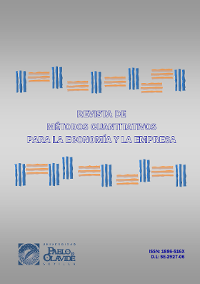Bifurcaciones de codimensión 2 en un modelo dinámico del mercado potencial y actual: aplicación al mercado cervecero español
DOI:
https://doi.org/10.46661/revmetodoscuanteconempresa.2123Palabras clave:
Bifurcaciones de codimensión 2, mercado cervecero español, codimension 2 bifurcations, Spanish brewer marketResumen
En este trabajo, a partir de la continuación de las bifurcaciones de codimensión 1 en un modelo dinámico discreto aplicado al mercado actual y potencial de las organizaciones, se establecen las condiciones necesarias para la existencia de bifurcaciones de codimensión 2. Como caso práctico, se estudia el caso del mercado cervecero español, considerando como referencia la marca “San Miguel”, analizando su evolución e interpretación económica.
Descargas
Citas
BISCHI, G.I., DIECI, R., RODANO, G., SALTARI, E. (2001). Multiple attractors and global bifurcations in a Kaldor-type business cycle model. Journal of Evolutionary Economics, 11 (5): 527–554.
BRAUN, M. (1990). Ecuaciones diferenciales y sus aplicaciones, Grupo editorial Americana, México D.F.
CHANG, J.J., CHANG, W.Y., LAI, C.C., WANG, P. (2007). Equilibrium dynamics in an endogenous growth model of money and banking, Journal of Money Credit and Banking, 39, 7: 1683–1710.
DONG, J., ZHANG, D., NAGURNEY, A.(1996). A projected dynamical systems model of general financial equilibrium with stability analysis. Mathematical and Computer Modelling, 24 (2): 35–44.
FEICHTINGER, G. (1992). Hopf bifurcation in an advertising difusion model, Journal of Economic Behavior and Organization 17, 401–411.
GANDOLFO, G. (1997). Economic Dynamics, third ed., Springer-Verlag, Berlin.
GOVAERTS, W.J. (2000). Numerical Methods for Bifurcations of dynamical equilibria, SIAM, Philadelphia.
GUCKENHEIMER, J., HOLMES, P. (1993). Nonlinear Oscillations, Dynamical Systems, and Bifurcations of Vector Fields, fourth ed., Springer-Verlag, New York.
GUCKENHEIMER, J., MYERS, M., STURMFELS, B. (1997). Computing Hopff Bifurcations I. Siam J. Numer. Anal., 34 (1): 1–21.
JOOSTER, R. (1996). Deterministic evolutionary dynamics: A unifying approach. Journal of Evolutionary Economics, 6 (3): 313–324.
KUZNETSOV, Y.A. (1998). Elements of Applied Bifurcation Theory, Applied Mathematical Sciences, second ed., Springer, New York.
KUZNETSOV, Y.A., LEVITIN, V.V. (2004). CONTENT. A multiplatform environment for analysing dynamical systems, http://www.math.uu.nl/people/Kuznet/CONTENT
LANDA, J., VELASCO, F. (2004). Análisis dinámico del mercado actual y potencial de las organizaciones. Revista Europea de Dirección y Economía de la Empresa, 13 (1): 131–140.
MITRA, T., NISHIMURA, K. (2005). Intertemporal complementarity and optimality study of a two-dimensional dynamical system, International Economic Review, 46 (1): 93–131.
NADAL, P. (2004). Bifurcaciones en modelos dinámicos discretos: Una aplicación al mercado cervecero, Tesis doctoral, Universidad de Sevilla.
NAGURNEY, A., ZHANG, D. (1996). On the stability of an adjustment process for spatial price equilibrium modelled as a projected dynamical system, Journal of Economics Dynamics & Control, 20 (1-3): 43–62.
ORTEGA, J.A., MARTÍNEZ, R., TORRES, J., TORO, M., GONZÁLEZ, L., VELASCO, F., ANGULO, C. (2005). Metodología semicualitativa para razonar sobre sistemas dinámicos. Computación y sistemas. Revista Iberoamericana de Computación. Vol. 8. Núm. 3: 231–251.
PERRINGS, C. (1998). Resilience in the dynamics of economy-environment systems, Environmental & Resource Economics, 11 (3-4): 503–520.
TSE, N.S.F., ROBB, F.F. (1994). Dynamical Systems Theory applied to Management Accounting-Chaos in cost behaviour in a standard costing system setting. Transactions of the Institute of Measurement and Control, 16 (5): 269–279.
VELASCO, F., BEGINES, F., NADAL, P., CHAMIZO, C., VÍLCHEZ, M. (2002). Continuación de los equilibrios de un sistema dinámico económico con bifurcaciones de codimensión 1 y 2, Computación y Sistemas 5 (3): 169–179.
VELASCO, F., NADAL, P., GONZÁLEZ, L., VÍLCHEZ, M.L. (2007). Estudio de la estabilidad y de las bifurcaciones de los equilibrios de un sistema dinámico. Aplicación al mercado cervecero español. Estudios de Economía Aplicada, 25 (1)(on line): 419–452.
VÍLCHEZ, M., VELASCO, F., GARCÍA, J. (2002). Bifurcaciones transcríticas y ciclos límite en un modelo dinámico de competición entre dos especies. Una aplicación a la pesquería de engraulis encrasicholus de la región suratlántica española, Estudios de Economía Aplicada, 20 (3): 651–677.
VÍLCHEZ, M., VELASCO, F., GONZÁLEZ L., ORTEGA, J. (2003). Bifurcaciones de Hopf: Análisis cualitativo y aplicación a un modelo bioeconómico de pesquerías, Computación y Sistemas, 6 (4): 273–283.
VÍLCHEZ, M., VELASCO, F., HERRERO, I. (2004). An optimal control problem with Hopf bifurcations and application to the striped venus fishery in the gulf of Cadiz, Fisheries Research, 67 (3): 295–306.
WIGGINS, S. (1990). Introduction to Applied Nonlinear Dynamical Systems and Chaos. Springer-Verlag.
Descargas
Publicado
Cómo citar
Número
Sección
Licencia
Derechos de autor 2009 Revista de Métodos Cuantitativos para la Economía y la Empresa

Esta obra está bajo una licencia internacional Creative Commons Atribución-CompartirIgual 4.0.
El envío de un manuscrito a la Revista supone que el trabajo no ha sido publicado anteriormente (excepto en la forma de un abstract o como parte de una tesis), que no está bajo consideración para su publicación en ninguna otra revista o editorial y que, en caso de aceptación, los autores están conforme con la transferencia automática del copyright a la Revista para su publicación y difusión. Los autores retendrán los derechos de autor para usar y compartir su artículo con un uso personal, institucional o con fines docentes; igualmente retiene los derechos de patente, de marca registrada (en caso de que sean aplicables) o derechos morales de autor (incluyendo los datos de investigación).
Los artículos publicados en la Revista están sujetos a la licencia Creative Commons CC-BY-SA de tipo Reconocimiento-CompartirIgual. Se permite el uso comercial de la obra, reconociendo su autoría, y de las posibles obras derivadas, la distribución de las cuales se debe hacer con una licencia igual a la que regula la obra original.
Hasta el volumen 21 se ha estado empleando la versión de licencia CC-BY-SA 3.0 ES y se ha comenzado a usar la versión CC-BY-SA 4.0 desde el volumen 22.










